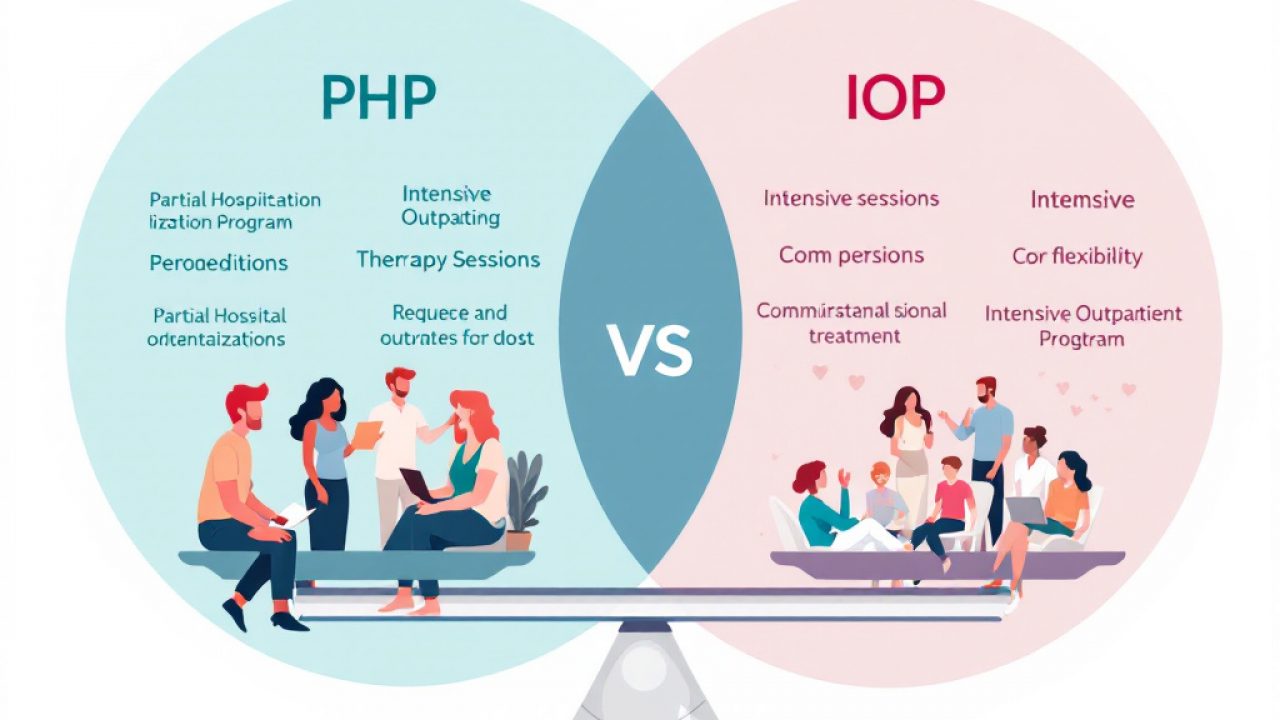Understand levels of care
When you’re exploring PHP vs IOP addiction treatment explained, it helps to place each program within the broader continuum of care. Outpatient options like Partial Hospitalization Programs (PHP) and Intensive Outpatient Programs (IOP) sit between inpatient or residential treatment and standard outpatient therapy. By understanding how each level of care differs in structure and support, you can make an informed choice that aligns with your recovery goals.
Define partial hospitalization program
A Partial Hospitalization Program offers a high level of outpatient support without requiring overnight stays. You typically attend:
- 5–7 days per week
- 4–6 hours of therapy each day
- 20–30 hours of clinical contact per week [1]
PHP is ideal if you need intensive daily care, close medical supervision, and immediate access to psychiatric services. You’ll return home or to a sober living environment in the evenings, which can ease the transition away from inpatient care.
Describe intensive outpatient program
An Intensive Outpatient Program provides structured treatment while preserving flexibility for work, school, or family commitments. You generally attend:
- 3–5 days per week
- 2–4 hours per session
- 9–20 hours of therapy per week [2]
IOP supports your independence in managing recovery. It’s often a step-down from PHP or inpatient care, helping you practice coping skills in real life with regular clinical supervision.
Place in continuum of care
Both PHP and IOP fill critical roles in the stages of addiction treatment and recovery. If you need more intensive support than traditional outpatient therapy, these programs bridge the gap between full residential stays and standard weekly counseling. To learn more about where outpatient options fit, see our guide on continuum of care in addiction recovery.
Compare program intensity
Choosing between a PHP and an IOP often comes down to differences in daily commitment, oversight, and treatment approaches. This section breaks down those core distinctions so you can assess which level of intensity suits your current needs.
Time commitment
- Partial Hospitalization Program
- 5–7 days per week, typically Monday through Friday
- 4–6 hours of structured therapy daily
- Intensive Outpatient Program
- 3–5 days per week, which may include evenings or weekends
- 2–4 hours per session
Because PHP demands more weekly hours, it’s better suited for individuals facing severe or co-occurring mental health disorders. If you need substantial daily support, PHP provides a nearly full-time therapeutic environment. IOP, on the other hand, allows you to maintain employment or schooling while receiving focused care.
Clinical oversight
Partial hospitalization programs deliver robust medical and psychiatric monitoring. You’ll have:
- Daily check-ins with psychiatrists or medical staff
- Immediate access to medication management
- Close tracking of withdrawal symptoms and side effects
IOPs offer regular clinical supervision but with fewer touchpoints. You’ll meet with therapists and case managers several times per week, promoting greater independence in managing your recovery. This model works well when you demonstrate stability and a supportive home environment.
Therapeutic approaches
Both PHP and IOP employ evidence-based modalities, such as:
- Cognitive Behavioral Therapy (CBT)
- Dialectical Behavior Therapy (DBT)
- Motivational Interviewing
- Family therapy components
PHP may also integrate psychoeducational workshops on stress management, communication, and emotional regulation, giving you practical tools for long-term wellness [3]. IOP focuses these interventions into shorter sessions, reinforcing skills as you apply them in daily life.
Evaluate duration and cost
Program length and financial considerations play a major role in your treatment decision. Understanding typical timeframes and expenses can help you plan for both recovery and budgeting.
Program length
- Partial Hospitalization Program
- Average duration: 2–4 weeks [2]
- Intensive Outpatient Program
- Average duration: 8–12 weeks, with the option to extend when needed [2]
Many clients step down from PHP to IOP as they gain stability, ensuring continuous support without overwhelm [4]. This phased approach helps you build confidence and resilience before returning fully to your routine.
Cost comparison
Cost varies by region and provider, but typical rates are:
| Program type | Daily cost | Weekly commitment |
|---|---|---|
| PHP | \$350–\$450 [1] | 20–30 hours |
| IOP | \$250–\$350 [1] | 9–19 hours |
Because PHP involves more clinical hours and onsite supervision, it carries a higher price tag. However, your insurance plan or financing options may offset costs. An extended IOP can be more cost-effective over time, especially if you’re juggling work and family responsibilities.
Review treatment outcomes
Effectiveness and transition planning are key to long-term success. Examining clinical results and the step-down process can clarify the impact of each program on your recovery journey.
Clinical effectiveness
Research shows meaningful reductions in substance use for both levels of care. After six months:
- PHP participants report a 60% reduction in substance use
- IOP participants report a 50% reduction in substance use [1]
These outcomes highlight the benefit of intensive outpatient options versus standard outpatient therapy. Both programs utilize structured interventions that address underlying issues and build coping skills.
Transition planning
Successful recovery often involves moving through multiple phases of care. A common path might include:
- Inpatient or residential detox
- Partial hospitalization for stabilization
- Intensive outpatient for skill consolidation
- Ongoing outpatient or aftercare groups
If you’re coming from an inpatient stay, learn more about putting each phase into context with our article on step-down care after residential treatment. Coordinated transition planning prevents gaps in support and reduces the risk of relapse.
Choose the right option
Ultimately, the best program aligns with your clinical needs, lifestyle demands, and personal goals. This section helps you weigh factors and highlights how Nova’s structured environment can support you.
Assess your needs
Ask yourself:
- Are you experiencing severe withdrawal or co-occurring mental health issues?
- Do you need daily medical oversight?
- Can you commit to 20–30 hours of therapy per week?
If you answer yes to these questions, PHP may be the right choice. If you’re stable enough to manage work or school while attending treatment, IOP could be more fitting. For help deciding, see how to choose the right addiction treatment program.
Consider personal factors
Other elements to factor in include:
- Support network at home
- Insurance coverage and out-of-pocket expenses
- Employment or school responsibilities
- Distance to the treatment facility
IOP offers flexibility for daily life, while PHP prioritizes clinical structure. Reflect on your unique situation to identify which model balances recovery and routine.
The Nova advantage
At Nova, you’ll find a supportive, clinically grounded environment that guides you through each step. Our structured outpatient program for recovery blends the intensity of PHP with the adaptability of IOP. You can expect:
- Individualized care plans tailored to your history and goals [5]
- Evidence-based addiction treatment options, including CBT and DBT [6]
- Family involvement through educational workshops and therapy sessions
- Smooth transitions between levels of care, ensuring continuity and confidence
By choosing Nova, you gain a partner committed to comprehensive care and lasting stability.
Plan next steps
Once you’ve compared PHP and IOP, you’re ready to move forward. This final section outlines how to get started and connect with support.
How to start
- Verify your insurance benefits for PHP and IOP coverage
- Schedule an initial assessment with our admissions team
- Complete any required intake paperwork
- Develop a personalized recovery roadmap
During your assessment, a clinical specialist will discuss your history, treatment objectives, and ideal level of care. This ensures your plan is evidence-based and aligned with best practices.
Contact Nova
Ready to explore your options? Reach out today:
- Call us at 1-800-NOVA-CARE
- Fill out our online form for a confidential consultation
- Learn more about what to expect during outpatient rehab in Charlotte, NC by visiting what to expect during outpatient rehab
Whether you choose PHP, IOP, or another level of care, Nova is here to support your journey. Take the first step toward lasting recovery and contact us now.
References
- (Changing Tides)
- (Resilience Recovery Resources)
- (Robert Alexander Center)
- (River’s Bend)
- (personalized treatment plans for recovery)
- (evidence-based addiction treatment options)








